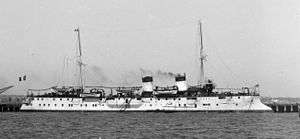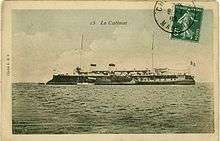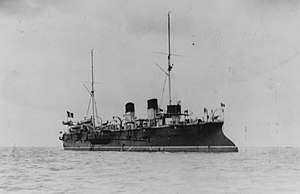Catinat-class cruiser
The Catinat class was a class of protected cruisers of the French Navy. The class comprised Catinat and Protet.
 Protet | |
| Class overview | |
|---|---|
| Name: | Catinat class |
| Builders: | |
| Operators: |
|
| Preceded by: | D'Assas class |
| Succeeded by: | D'Entrecasteaux |
| Built: | 1894–1899 |
| In service: | 1898–1911 |
| Completed: | 2 |
| Retired: | 2 |
| General characteristics | |
| Type: | Protected cruiser |
| Displacement: | 4,001–4,048 long tons (4,065–4,113 t) |
| Length: | 98.09 m (321 ft 10 in) pp |
| Beam: | 13.59 m (44 ft 7 in) |
| Draft: | 6.43 m (21 ft 1 in) |
| Installed power: |
|
| Propulsion: |
|
| Speed: | 19.5 to 20 knots (36.1 to 37.0 km/h; 22.4 to 23.0 mph) |
| Range: | 6,000 nmi (11,000 km; 6,900 mi) at 10 kn (19 km/h; 12 mph) |
| Complement: | 400 |
| Armament: |
|
| Armor: |
|
Design
In response to a war scare with Italy in the late 1880s, the French Navy embarked on a major construction program in 1890 to counter the threat of the Italian fleet and that of Italy's ally Germany. The plan called for a total of seventy cruisers for use in home waters and overseas in the French colonial empire. The Catinat class were ordered to as part of the program, and they were based on the earlier Descartes class.[1][2] The Catinat-class ships were intended to operate in France's overseas colonies.[3]
General characteristics and machinery

The ships of the Catinat class were 98.09 m (321 ft 10 in) long between perpendiculars and 100.20 m (328 ft 9 in) long overall. They had a beam of 13.59 m (44 ft 7 in) and a draft of 6.43 m (21 ft 1 in). Catinat displaced 4,048 long tons (4,113 t), while Protet displaced 4,001 long tons (4,065 t). Protet suffered from stability problems and had to have ballast added, accounting for her greater displacement.[3][4]
Like most French warships of the period, the Catinat-class cruisers' hulls had a pronounced ram bow, tumblehome shape, and a short forecastle deck. Below the waterline, the hulls were covered in a layer of wood and copper sheathing to protect them from biofouling on long voyages overseas. The ships had a minimal superstructure, consisting primarily of a small conning tower and a bridge. They were originally to have been fitted with heavy military masts, but during construction, these were replaced with lighter pole masts with spotting tops for observation and signaling purposes. Their crew numbered 400 officers and enlisted men.[4][5]
The ships' propulsion system consisted of a pair of vertical triple-expansion steam engines driving two screw propellers. Steam was provided by sixteen coal-burning Belleville-type water-tube boilers that were ducted into two funnels. Their machinery was rated to produce 7,000 indicated horsepower (5,200 kW) normally, and up to 9,000 ihp (6,700 kW) using forced draft, for a top speed of 19 knots (35 km/h; 22 mph). In service, the ships were capable of 9,500 ihp (7,100 kW) for a speed of 19.5 to 20 knots (36.1 to 37.0 km/h; 22.4 to 23.0 mph). Coal storage amounted to 560 long tons (570 t),[3][4] which allowed the ships to steam for 6,000 nautical miles (11,000 km; 6,900 mi) at a speed of 10 knots (19 km/h; 12 mph).[6]
Armament and armor
._Pi%C3%A8ce_de_100_de_marine_-_Fonds_Berthel%C3%A9_-_49Fi1270_(cropped).jpg)
The ships were armed with a main battery of four 164 mm (6.5 in) Modèle 1893 45-caliber guns. They were placed in individual sponsons clustered amidships, two guns per broadside.[4] They were supplied with a variety of shells, including solid, 45 kg (99 lb) cast iron projectiles, and explosive armor-piercing (AP) and semi-armor-piercing (SAP) shells that weighed 54.2 kg (119 lb) and 52.6 kg (116 lb), respectively. The guns fired with a muzzle velocity of 770 to 800 m/s (2,500 to 2,600 ft/s).[7]
The main battery was supported by a secondary battery of ten 100 mm (3.9 in) Modèle 1891 guns, which were carried in a variety of mounts. Two guns fitted with gun shields were placed side-by-side in pivot mounts on the upper deck, four more were in the upper deck forward in casemates. Another pair of guns were in sponsons further aft, and the remaining pair were in pivot mounts on the upper deck aft.[4] The guns fired 14 kg (31 lb) cast iron and 16 kg (35 lb) AP shells with a muzzle velocity of 710 to 740 m/s (2,300 to 2,400 ft/s).[8]
For close-range defense against torpedo boats, they carried ten 47 mm (1.9 in) 3-pounder Hotchkiss guns and four 37 mm (1.5 in) 1-pounder guns, all in individual pivot mounts. They were also armed with two 350 mm (14 in) torpedo tubes in their hulls above the waterline. They had a capacity to carry fifty naval mines, which were stored in the compartment for the steering engine. A rail extended aft, through the captain's cabin, to a port in the stern, where the mines could be dropped into the ships' wake.[4]
Armor protection consisted of a curved armor deck that was 30 mm (1.2 in) thick on the flat portion, curving down at the sides, where it increased in thickness to 60 mm (2.4 in). Toward the bow and stern, the deck was reduced slightly to 25 mm (0.98 in). Above the deck, a cellular layer of watertight compartments was intended to contain flooding below the waterline. A light splinter deck covered the propulsion machinery spaces to protect them from shell fragments that penetrated the main armor deck. The gun shields for the deck-mounted 100 mm guns were 50 mm (2 in) thick. The ships had 70 mm (2.8 in) plating on the conning tower.[2]
Construction
| Name | Laid down[4] | Launched[9] | Completed[4] | Shipyard[4] |
|---|---|---|---|---|
| Catinat | February 1894 | 8 October 1896 | 1898 | Société Nouvelle des Forges et Chantiers de la Méditerranée, La Seyne-sur-Mer |
| Protet | March 1896 | 6 July 1898 | February 1899 | Forges et Chantiers de la Gironde, Lormont |
Service history

Notes
References
| Wikimedia Commons has media related to Catinat class cruisers. |
- Friedman, Norman (2011). Naval Weapons of World War One: Guns, Torpedoes, Mines and ASW Weapons of All Nations; An Illustrated Directory. Annapolis: Naval Institute Press. ISBN 978-1-84832-100-7.
- Garbett, H., ed. (May 1904). "Naval Notes: France". Journal of the Royal United Service Institution. London: J. J. Keliher & Co. XLVIII (315): 560–566. OCLC 1077860366.
- Gardiner, Robert, ed. (1979). Conway's All the World's Fighting Ships 1860–1905. London: Conway Maritime Press. ISBN 978-0-85177-133-5.
- Gardiner, Robert & Gray, Randal, eds. (1985). Conway's All the World's Fighting Ships: 1906–1921. Annapolis: Naval Institute Press. ISBN 978-0-87021-907-8.
- Glennon, J. H., ed. (1894). "The Decennial Programme for Naval Construction in France". Proceedings of the United States Naval Institute. Annapolis: Naval Institute Press. XX (4): 832–838.
- Ropp, Theodore (1987). Roberts, Stephen S. (ed.). The Development of a Modern Navy: French Naval Policy, 1871–1904. Annapolis: Naval Institute Press. ISBN 978-0-87021-141-6.